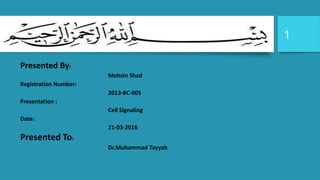
Cell Signaling Presentation by Mohsin Shad
- 1. Presented By: Mohsin Shad Registration Number: 2013-BC-005 Presentation : Cell Signaling Date: 21-03-2016 Presented To: Dr.Muhammad Tayyab 1
- 3. Taste Receptor • Receptor that facilitates the sensation of taste. • When food or other substances enter the mouth • Molecules interact with saliva and are bound to taste receptors • Present in Oral cavity and throat. • It is type of chemoreceptors that is present on taste buds • Taste buds- epithelial cells that act like neurotransmitters • Innervated by cranial nerves 3
- 4. Taste • Taste (‘gustation’) is often referred to as the chemical senses • They are mediated in the first instance by receptors that are stimulated by chemical substances. • Receptors are called ‘ chemoreceptors • Taste: Chemicals dissolve in our mouth (must be water soluble) and stimulate the taste buds in the oral cavity (tongue, soft palate, cheek, etc.). 4
- 5. Types of Tastes Taste = ‘Gustation Basic tastes: 1= Sweetness - outer tip of tongue 2= Saltiness - lateral edge of tongue behind tip 3= Sourness - lateral edge of tongue behind saltiness region 4=Bitterness - back edge of tongue toward throat 5= Umami - taste of glutamate - not localized 5
- 6. Taste Modalities over Tongue 6
- 7. Four Major Sensations of Taste • Sweet- G-protein activates second messenger system • Bitter- also G-protein activated specific receptor • Sour- proton channel (acids taste sour) • Salty- sodium channels Tastes seem to be enhanced in different parts of the tongue 7
- 8. Different ions or Receptors for Different Tastes 8
- 9. Organ of Taste • The tongue is the major organ of gustation • There are also some taste buds on the palate, pharynx, and epiglottis Papillae - contain taste buds • Fungiform papillae (mushrooms) - top surface of tongue • Foliate papillae (ridges) - rear, lateral margin of tongue • Vallate papillae (pimples) - rear, medial margin of tongue 9
- 10. 10
- 11. Taste buds • Only 1% of the epithelial cells on tongue’s surface are taste buds • Contain 50 to 75 sensitive cells each • Taste-sensitive cells have a limited lifetime, and are constantly being replaced. • Taste pore permits substances to enter • Three cell types in each taste bud: • Taste receptors – chemoreceptors • Basal cells - source of new taste receptors • Gustatory afferent fibers - conduct action potentials to brain 11
- 12. Taste cells – Taste Receptors • Come from the division and differentiation of the basal cells • Not neurons in the strict sense, but have synapses with gustatory afferent fibers • Arrival of chemical molecules on surface leads to change in membrane potential - receptor potential • Most taste receptors respond to at least two of the basic tastes • Sometimes taste receptors generate action potential • Transduction differs for each type of taste receptor 12
- 13. Neural Pathways for Taste • Afferents • Anterior 2/3 of tongue - VII (facial nerve) • Posterior 1/3 of tongue - IX (glossopharyngeal nerve) • glottis, epiglottis, pharynx, palate - X (vagus nerve) • All afferent fibers end in gustatory nucleus in the medulla 13
- 14. Pathways to the Brain • Taste fibers proceed along several pathways to the medulla oblongata or brain stem, then to the thalamus, and finally to the taste area on the anterior cortex. • For taste sensation, gustatory nucleus neurons send fibers to the ventral posterior medial nucleus (VPM) of thalamus 14
- 15. Pathways to the Brain • VPM sends fibers to the primary gustatory cortex ( Brodmann's area 43 in ventral parietal lobe • For autonomic functions, gustatory nucleus sends fibers to the many brainstem regions involved in swallowing, salivation, gagging, vomiting, digestion, respiration and to the hypothalamus and amygdala • appetite and food preferences 15
- 16. Clinical Considerations • Ageusia: Absence of sense of taste • Dysgeusia: Disturbed sense of taste • Hypogeusia: Diminished sense of taste • Hypergeusia: Increased sense of taste 16
- 17. 17Any Question ? For Listening My Presentation